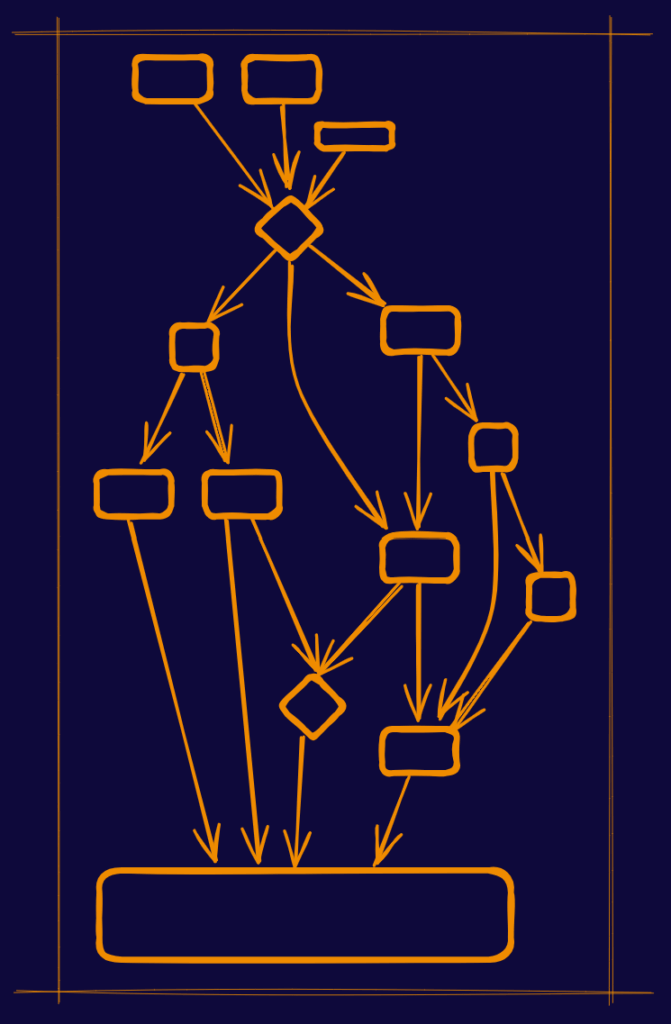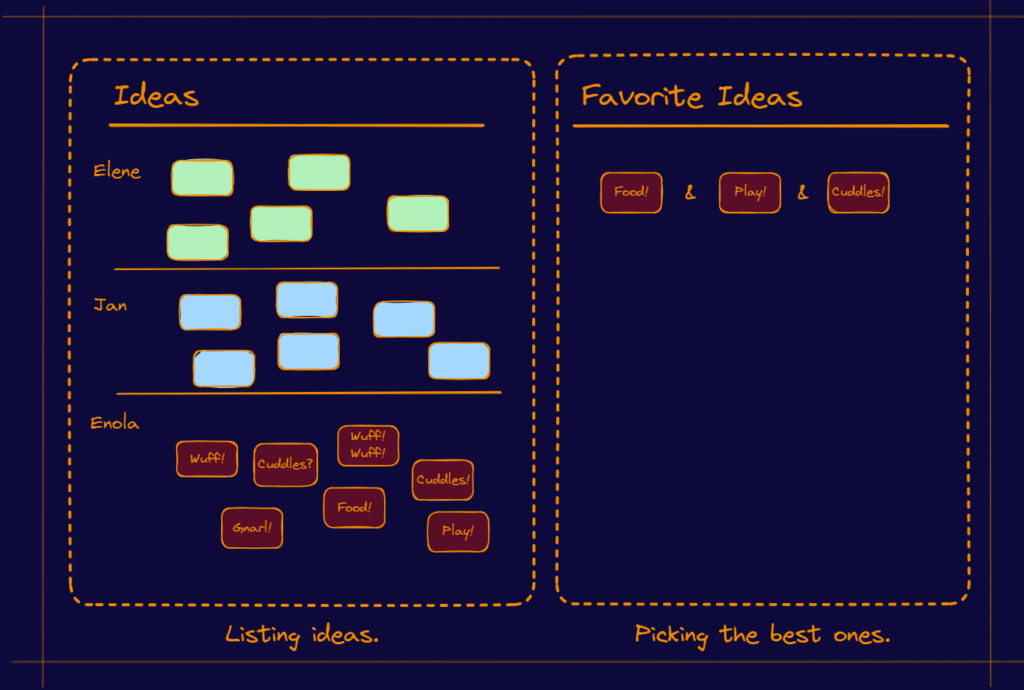Intro
We’re meeting more than ever and often for the wrong reasons [§ Caimi 2014], [§ Atlassian 2024].

Calendar invites go out like reflexes. Weekly stand-ups, check-ins, brainstorms, syncs, touchpoints. But ask someone: “What was that meeting actually for?” and you’ll likely get a shrug.
But although meetings can be wasteful they’re not inherently bad. In fact, when used for the right purpose, they can be one of the most effective tools a team has. So let’s ask the real question:
Why should we meet?
Meetings Need a Purpose
Every meeting consumes time, attention, and energy [§ Leroy 2009]. That means they should be intentional, not habitual. Not everything needs a Zoom call, but some things absolutely do.
Here are working purposes that make the “Pain of getting Together” worth it.
Decision-Making
A few years ago, we had an ongoing internal debate about data types. Messages flew back and forth, ad hoc calls came and went, yet no decision was made. Frustration grew until I finally called a proper meeting with all stakeholders. Thirty minutes later, the issue was resolved.
Some decisions can’t be made asynchronously. When stakes are high or the issue is complex, bringing the right people together in real time enables faster resolution, clearer trade-offs, and stronger commitment to the outcome [§ Leach 2009].

Idea generation (Brainstorming & Problem-Solving)
Creativity loves conversation. Well-facilitated brainstorming sessions allow people to bounce ideas, combine insights, and trigger solutions that would never surface in isolation.
When team members build on each other’s contributions, collaborative idea generation often outperforms working alone [§ Paulus 2000].
If a problem feels stuck—just missing that one creative spark—a short, focused brainstorm might be exactly what’s needed.
And if no one else is around? Don’t forget the duckling method: explaining the problem out loud—even to a rubber duck—can work wonders on its own.

Conflict Resolution
Some tensions can’t be resolved over Slack or email. When emotions flare or priorities clash, live meetings offer empathy, body language, and the space needed for true dialogue and negotiation [§ Smith 2004].
Here science offers the following key point:
Conflicts occur more often and escalate more in online-only communication. Face-to-face or synchronous meetings, by contrast, support stronger norms, trust, and effective resolution.
[§ Kahlow 2020]
Meta-analytic research further shows that both task-related and relationship-based conflicts harm team satisfaction and performance, but face-to-face formats help prevent the escalation from task conflict into personal, relationship conflict [§ Dreu 2003].
In short: If the issue matters enough to spark tension, resolving it live, with tone, nuance, and trust, produces better outcomes than trying to sort it out asynchronously.

Feedback & Coaching
Whether it’s a formal performance review or an informal course correction, feedback lands far better in conversation than via email. Meetings allow for tone awareness, mutual understanding, and the space to respond and clarify in real time. Studies show that face-to-face verbal feedback, compared to none or only written feedback, leads to significant performance improvements—highlighting the unique value of conversational feedback [§ Kluger 1996, § Hattie 2007].

Relationship Building
At a previous company I worked for, we were encouraged to have “coffee dates.” These weren’t status updates or task syncs, they were relaxed chats where we shared more about our personal lives than our project lists. And it paid off. Knowing each other better deepened trust and made collaboration smoother. The impact wasn’t just anecdotal, science agrees [§ Edmondson 1999, § Smith 2004].
Not every meeting has to be about tasks. Sometimes, it’s about trust. Especially in hybrid teams, meetings maintain human connection, reinforce team culture, and build the psychological safety that underpins high performance.

Outro — If You Don’t Have One of These, Cancel the Meeting
Here’s your cheat sheet:
| Meeting Purpose | Use When… |
|---|---|
| ✅ Decision-Making | You need real-time alignment to make a choice |
| 💡 Brainstorming | You need ideas from multiple minds |
| 🤝 Conflict Resolution | You need empathy and negotiation |
| 📈 Feedback & Coaching | You want performance conversations with nuance |
| ❤️ Relationship Building | You want to maintain trust and team cohesion |
If your meeting doesn’t serve one of these purposes, don’t schedule it.
Or replace it with a doc, a voice memo, or—radical idea—nothing at all.
Sources
| Key | Citation |
|---|---|
| Atlassian 2024 | Atlassian. (2024, March 27). Workplace woes: Meetings aren’t working. https://www.atlassian.com/blog/workplace-woes-meetings |
| Caimi 2014 | Caimi, G. (2014). Your scarcest resource. Harvard Business Review, 74-80. |
| Dreu 2003 | De Dreu, C. K., & Weingart, L. R. (2003). Task versus relationship conflict, team performance, and team member satisfaction: a meta-analysis. Journal of applied Psychology, 88(4), 741. |
| Edmondson 1999 | Edmondson, A. (1999). Psychological safety and learning behavior in work teams. Administrative science quarterly, 44(2), 350-383. |
| Hattie 2007 | Hattie, J., & Timperley, H. (2007). The power of feedback. Review of educational research, 77(1), 81-112. |
| Kahlow 2020 | Kahlow, J. K. J., Klecka, H. K. H., & Ruppel, E. R. E. (2020). What the differences in conflict between online and face-to-face work groups mean for hybrid groups: A state-of-the-art review. Review of Communication Research, 8, 51-77. |
| Kluger 1996 | Kluger, A. N., & DeNisi, A. (1996). The effects of feedback interventions on performance: a historical review, a meta-analysis, and a preliminary feedback intervention theory. Psychological bulletin, 119(2), 254. |
| Leach 2009 | Leach, D. J., Rogelberg, S. G., Warr, P. B., & Burnfield, J. L. (2009). Perceived meeting effectiveness: The role of design characteristics. Journal of Business and Psychology, 24, 65-76. |
| Leroy 2009 | Leroy, S. (2009). Why is it so hard to do my work? The challenge of attention residue when switching between work tasks. Organizational Behavior and Human Decision Processes, 109(2), 168-181. |
| Paulus 2000 | Paulus, P. B., & Yang, H. C. (2000). Idea generation in groups: A basis for creativity in organizations. Organizational behavior and human decision processes, 82(1), 76-87. |
| Smith 2004 | Smith, K. G. (2004). The Southwest Airlines Way: Using the Power of Relationships to Achieve High Performance. |


Leave a Reply